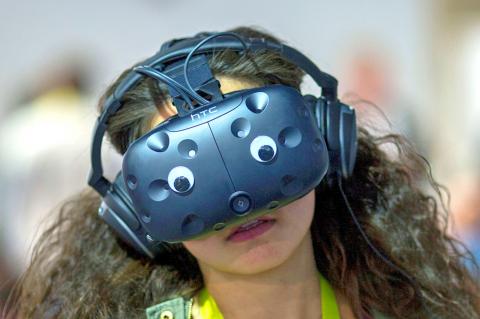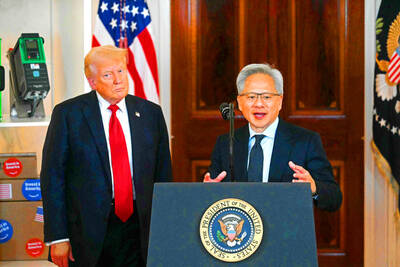Virtual reality (VR) sought its stride on Friday last week at the Consumer Electronics Show, where despite being a hot topic there was little sign it is racing into mainstream culture.
Show floor space devoted to virtual reality abounded with companies diving into the market with headsets, content, or tools for better creating or delivering immersive experiences.
Last year at the show, virtual reality was an eye-grabbing sensation. This time around there was a focus on what it is going to take to get it into the hands of the masses.

Photo: AFP
Shawn DuBravac, chief economist at the Consumer Technology Association behind the annual show, was confident that sales of mixed reality gear would grow and the range of uses expand far beyond video games.
“There is a lot of investment going into content,” DuBravac said. “Sales will eventually come.”
HTC Corp (宏達電) used the show to announce initiatives aimed at getting developers to create more VR experiences and revealed plans for arcades in public venues so more people could give it a try.
HTC had a “great” year with its Vive VR head wear and Steam online game venue, but was “really just scratching the surface,” Vive general manager Daniel O’Brien said. “Our goal is to build the largest VR platform in the world.”
“2016 was a coming out party for VR; 2017 is developing it in the marketplace and continuing to evolve the product,” O’Brien said.
HTC Vive is up against Sony Corp’s PlayStation VR and Facebook Inc-owned Oculus Rift. Each company has been wooing software developers and refining its hardware to better entice users.
HTC said that later this year it will release a Vive Tracker device that lets digital versions of real-world objects easily be put into fantasy worlds.
O’Brien also said that HTC is working on a wireless version of its headset, to sate a strong desire to be able to move around untethered to computers while using Vive.
Rikard Steiber, head of Viveport virtual reality app shop, said that more than 3,000 titles for the Vive platform would be available by the end of this year.
The vision is to have Viveport serve all VR platforms, including those of Oculus and Sony, according to Steiber.
HTC said it will launch what it billed as the world’s first virtual reality app subscription service, likened to “Netflix for VR.”
The goal is to help developers reach audiences and make money, ideally inspiring the creation of more VR content, according to HTC executives.
The Taiwanese company also planned to bring VR to the masses in arcades in shopping malls, down towns or other public locations. The company envisioned thousands of Viveport Arcades in operation by the end of this year.
Sony chief executive Kazuo Hirai revealed at the show that the Japanese consumer electronics company had sold more than 53.4 million PlayStation 4 consoles, which can power it virtual reality head gear.
He said that Sony aimed to continue the console momentum with more services and content, including VR games.
Sony Pictures was among more than two dozen companies that used the show to announce the creation of a Virtual Reality Industry Forum.
The Forum said its goal is to “further the widespread availability of high-quality audiovisual VR experiences.”
The group wants standards and formats that allow rich VR content to be equally accessible from the array of devices, avoiding “fragmentation” that has plagued audio-visual media in the past, according to a release.
“We believe this is crucial for the market to take off,” Sky broadcast strategy chief engineer Chris Johns said in the release. “We all expect that 2017 will be the year when intense consumer interest in VR spurs a quantum leap in the user experience.”
This year’s event featured the largest collection of VR technology ever at a trade show, according to Gartner Inc analyst Brian Blau.
“There is a bit of the cart being before the horse,” Blau said. “A lot of people have learned about it, but people aren’t really buying it.”
He described the VR scene at the show as the first incarnation of an ecosystem of devices, applications and services in what was a big step for the technology.
“There is nothing like putting it on and experiencing it,” Blau said of VR. “The disappointing part is that it is quite expensive. VR will be held back a bit until quality goes up and price goes down.”

Taiwan Semiconductor Manufacturing Co (TSMC, 台積電) last week recorded an increase in the number of shareholders to the highest in almost eight months, despite its share price falling 3.38 percent from the previous week, Taiwan Stock Exchange data released on Saturday showed. As of Friday, TSMC had 1.88 million shareholders, the most since the week of April 25 and an increase of 31,870 from the previous week, the data showed. The number of shareholders jumped despite a drop of NT$50 (US$1.59), or 3.38 percent, in TSMC’s share price from a week earlier to NT$1,430, as investors took profits from their earlier gains

In a high-security Shenzhen laboratory, Chinese scientists have built what Washington has spent years trying to prevent: a prototype of a machine capable of producing the cutting-edge semiconductor chips that power artificial intelligence (AI), smartphones and weapons central to Western military dominance, Reuters has learned. Completed early this year and undergoing testing, the prototype fills nearly an entire factory floor. It was built by a team of former engineers from Dutch semiconductor giant ASML who reverse-engineered the company’s extreme ultraviolet lithography (EUV) machines, according to two people with knowledge of the project. EUV machines sit at the heart of a technological Cold

CHINA RIVAL: The chips are positioned to compete with Nvidia’s Hopper and Blackwell products and would enable clusters connecting more than 100,000 chips Moore Threads Technology Co (摩爾線程) introduced a new generation of chips aimed at reducing artificial intelligence (AI) developers’ dependence on Nvidia Corp’s hardware, just weeks after pulling off one of the most successful Chinese initial public offerings (IPOs) in years. “These products will significantly enhance world-class computing speed and capabilities that all developers aspire to,” Moore Threads CEO Zhang Jianzhong (張建中), a former Nvidia executive, said on Saturday at a company event in Beijing. “We hope they can meet the needs of more developers in China so that you no longer need to wait for advanced foreign products.” Chinese chipmakers are in

POLICY REVERSAL: The decision to allow sales of Nvidia’s H200 chips to China came after years of tightening controls and has drawn objections among some Republicans US House Republicans are calling for arms-sale-style congressional oversight of artificial intelligence (AI) chip exports as US President Donald Trump’s administration moves to approve licenses for Nvidia Corp to ship its H200 processor to China. US Representative Brian Mast, the Republican chairman of the US House Committee on Foreign Affairs, which oversees export controls, on Friday introduced a bill dubbed the AI Overwatch Act that would require the US Congress to be notified of AI chips sales to adversaries. Any processors equal to or higher in capabilities than Nvidia’s H20 would be subject to oversight, the draft bill says. Lawmakers would have